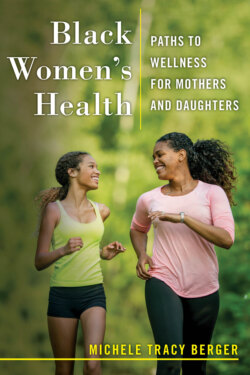Читать книгу Black Women's Health - Michele Tracy Berger - Страница 12
Black Women’s and Girls’ Activism Intersecting with Health
ОглавлениеIn the year 2015, several Black women activist groups showed the power of Black women: #Blacklivesmatter #Sayhername, #SandraBland, #BreeNewsome are movements to claim Black women’s rights as human rights.66
In the last five years, the political terrain has exploded with activism led by Black women and Black girls articulating the structural realities they face. Responding to the multifaceted threats on Black Life, including police brutality, sexual violence, and political viability, has brought issues of Black women’s and girls’ health into popular focus. There is a recognition that ongoing legacies of trauma and violence impact Black women’s and girls’ mental, physical, and spiritual well-being. The year 2015 was a watershed moment, as Evans notes above, and Black women’s activism has continued. We can also include Tamara Burke and the founding of the #MeToo movement in this explosion.
Black Lives Matter brought to the forefront issues of police brutality and the failures of the criminal justice system, while challenging the narrative of a post-racial America. Within the context of organizing, Black women systematically challenged their own exclusion from being seen as worthy victims. Within the context of this discussion, a broader political space emerged that examines the ways in which Black girls’ lives are devalued.
Activists and scholars have offered a chilling picture of the state of Black girls’ well-being in the United States. Black girls tend to battle greater stressful life events than many of their counterparts. For instance, the Girl Scouts’s 2013 State of the Girls report found that Black girls are more likely than any other members of racial or ethnic groups to: live in single-parent households, report being hit by a boyfriend, and be overweight or obese. Additionally, this group has a teen birth rate two times that of the national average and has a poverty rate that is double that of white girls. The 2019 report, “Girlhood Interrupted: The Erasure of Black Girls Childhood,” presents evidence demonstrating that Black girls face the distinct challenges of being seen as more mature and less innocent by adults.67 Black girls are less likely to be viewed as deserving to be treated (and protected) as children. Authors of the report argue that this level of “adultification”68 puts Black girls at risk for various kinds of violence. A particularly egregious example of this kind of perception is the treatment in 2015 of Dajerria Becton, the fifteen-year-old Black girl who was slammed down to the ground at a pool party by Eric Casebolt, a police officer.
Black girls are also vulnerable in many institutions, including schools. Kimberlé Crenshaw, gender and racial equity pioneer, co-authored a report titled, “Black Girls Matter: Pushed Out, Overpoliced and Underprotected,” that highlights the ways that schools reinforce sexism and racism and thus reduce Black girls’ educational opportunities. This report, which received major press, highlights how schools curtail their “educational opportunities, and marginalize their needs, while pushing them into low-wage work, unemployment, and incarceration.”69
These negative patterns and their impact definitely do not contribute to the flourishing of Black girls’ well-being. Crenshaw critiques the focus on young Black boys and systemic oppression with policy remedies that are not intersectional and that overlook the needs of Black girls. Refocusing on Black girls and women through policy and community, as Crenshaw argues, helps us mobilize creativity and energy to find solutions that do not replicate traditional patriarchal norms.70 In this vein, some scholars are building creative interventions based on a strength and resiliency model of Black women’s and girls’ experiences.71 These interventions often have well-being and health at their center. African American female digital activism has been particularly powerful as it emphasizes well-being, self-care, and health as part of a political orientation.72
The rise of #BlackGirlMagic as a recent set of aesthetic and activist practices reveals the multiple and creative ways Black girls and women use poetry and other creative expressions to counter negative experiences and engage resistance. The social movement began in cyberspace but has since evolved to encompass organizing practices and spaces offline. Julia Jordan Zachery and Duchess Harris explore how #BlackGirlMagic is an articulation of the multiples ways in which “Black femmes, women and girls” make themselves visible and legible using creative methodologies, representations, and practices within the face of structural oppressions.73
These important developments continue to shape the discursive and political terrain about the meanings and practice of health for Black women and girls.
